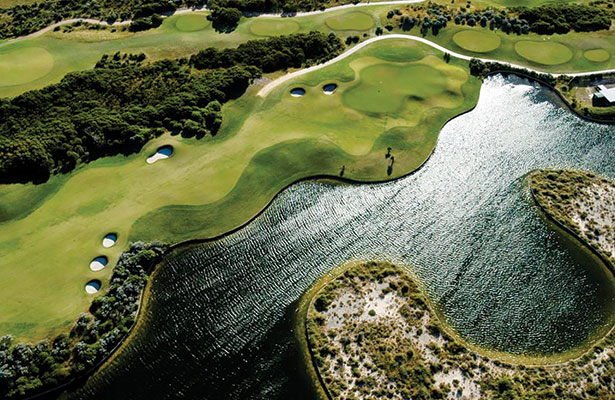In the late 1990s, prominent West Australian golf architect Michael Coate and the late Roger Mackay teamed up with 1991 British Open champion Ian Baker-Finch to design Links Kennedy Bay. What they wanted was to give Western Australia a fitting tribute to the links courses of Scotland. What they got was a golf course that is continually ranked among Australia’s top 25.
ANY golf courses attempt to emulate the experience of Great Britain’s links layouts. Few do it well, and even fewer achieve an end product that rates among the best layouts in their respective countries. But 40 minutes south of Perth sits a golf course that has, during the past seven years, never ventured worse than No.23 on the Australian Golf Digest Top 100 Courses list.
Take the drive down WA’s Kwinana Freeway and you’ll see why this course has been voted No.20, 20, 23 and 23 in our previous four rankings, conducted every two years. Opened in 2000, its Port Kennedy location combines the area’s infamous trade winds with the subtle undulations of the real estate, as well as coastal vegetation featuring western wattle, grevillea, sedges and lilies. Atop this incredible foundation sits a beautiful and fair test of golf – rolling Windsor Green couch fairways, imposing sand hills, perched bentgrass green complexes and the soothing sound of crashing Indian Ocean waves nearby. There’s a lot to like about Link Kennedy Bay, so let’s talk about some of the highlights:
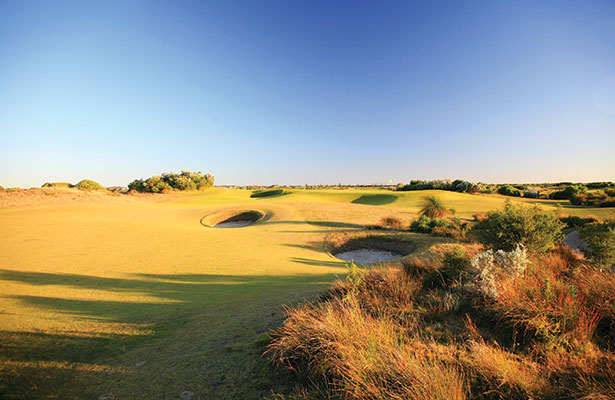
The Pot Bunkers
Beware the pot bunkers at the Links Kennedy Bay – all 115 of them. With revetted faces, they are undoubtedly the standout feature of Kennedy Bay – not just because they resemble the deep traps of British Open venues, but for how strategically they are placed within driving zones and around the greens. For your approach shots, the correct line is rewarded while the wrong line appears to make the bunkers act like a magnet for golf balls. The same goes from the tees at Links Kennedy Bay – hard, fast-running fairways laid on top of a sandy base provide a distance boost to well-placed drives, while bringing the bunkers more into play for errant tee shots. This is precisely where the consultation of Baker-Finch paid dividends for Mackay and Coate – his Claret Jug-winning expertise evident in the rewarding, minimalistic feel of Kennedy Bay’s bunkering. When you compare 115 traps to the 1,072 Jason Day had to battle at Whistling Straits this year for his breakthrough US PGA Championship victory, it doesn’t seem like a big number. But wait until you land in one.
“The bunkering I’m really proud of,” Baker-Finch says from his Florida home. “They’re beautiful with those revetted faces and there’s no pattern to them; they’re not cookie cut. They are as bunkers were originally intended for golf – as hazards carved by nature. The ground around the bunker gathers the ball into the trap.”
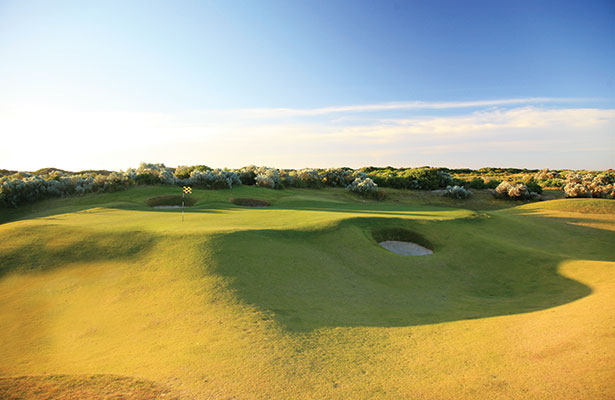
The Green Complexes
It is evident Michael Coate learned his architectural craft under Peter Thomson and Mike Wolveridge – the green complexes at Links Kennedy Bay have a distinct Thomson feel. The perched putting surfaces encourage flighted approach shots, but manicured couch fringes encourage rolling the ball up to the flag. Steep embankments also place a premium on distance control as errant approaches run down to unforgivable positions. These green complexes add a touch of prestige to the course, particularly the par-3 sixth.
“The green shapes are total links design and links feel,” says Baker-Finch, whose unpaid input was “a labour of love.”
“Some of Peter Thomson’s green complex philosophy definitely rubbed off on Michael (Coate), but he also travelled to the UK and studied the links courses there and that’s why you get such a genuine experience at Kennedy Bay.”
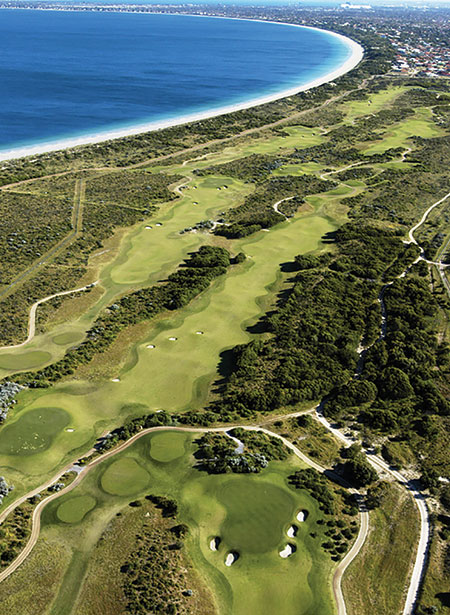
The Pars 3s
While the bunkering is the star attraction at Links Kennedy Bay, the par 3s play a commendable supporting role. The sixth is stunning and arguably one of the best holes on the course. This 179-metre gem features a heart-shaped, elevated green guarded by five bunkers and steep run-offs. The 14th is a magnificent par 3 that plays short from every option except from the black tees and intimidates the golfer with vegetation left and right, as well as small (but deep) greenside pot bunkers. The third and 16th are much shorter in length, but with lofted clubs these two holes intentionally expose your golf ball to the fearsome trade winds.
The Layout
From a central clubhouse, the course is arranged in two loops, each running along a series of small dune ridges and shallow natural valleys. The front nine is a solid introduction to the course, but the back nine is far more memorable. While the opening hole is a mid-sized par 4, holes four to seven stand out. You’ll let out a chuckle at the par-5 fourth, named ‘Hell’ for it is the longest hole on the course at 520m. Either side of the beautiful sixth are two contrasting holes – the devilish, par-4 fifth (420m) and the driveable par-4 seventh.
The glamour holes of the back nine begin at the 11th, named ‘Split Decision’, for its fairway is strategically divided and rewards those taking the tighter, bunkered side. Next up is an enjoyable nod to Baker-Finch – a 309m par 4 dubbed ‘Finchy’s Folly’. Then, the run home is magnificent. From the attractive 125m, par-3 16th (‘Wee Tap’) to the par-5 penultimate hole (‘The Doctor’), Links Kennedy Bay comes home with a wet sail.
“I would say, in my opinion, it is one of the best links experiences in Australia,” says Baker-Finch. “It’s different to (Tasmania’s)Barnbougle Dunes – that is a phenomenal track when we look at ocean-side courses. But Kennedy Bay is as close to British Isles links golf you can get with warm climate grasses. It’s so hard to recreate that without using cool climate grasses. To me, it’s 18 totally different and great golf holes.”
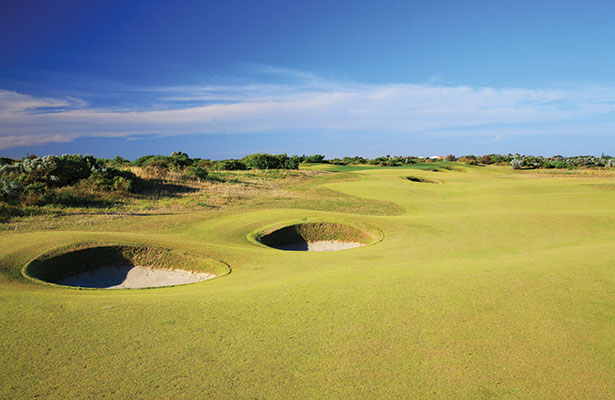
‘The Doctor’
The legendary ‘Fremantle Doctor’ is another resemblance to Scottish-style golf. This afternoon coastal breeze adds another element to battle during your round and emphasises the demanding golf on the back nine. The Doctor works in concert with the sand dunes, tight surfaces and pot bunkers to give golfers a taste of what it’s like to play at the cradle of the game. However, the sunshine and warm climate is good reminder that you are indeed in Western Australia.
The Links Kennedy Bay
Lot 199 Port Kennedy Drive
Port Kennedy WA 6172.
Phone: (08) 9524 5991

